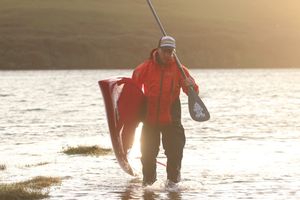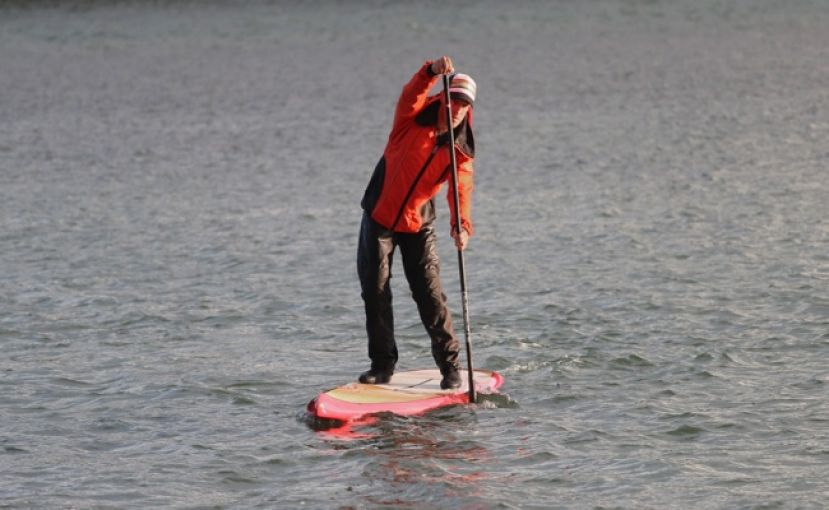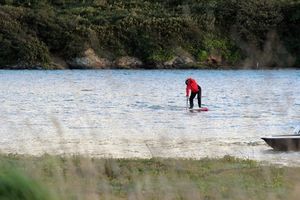Ocean Rodeo Shares Insight On New Dry Suit
- Written by Staff
- Published in News
- Comments::DISQUS_COMMENTS
 |
VANCOUVER ISLAND, Canada - Winter presents a tricky dynamic for paddlers. It can be difficult to strike a balance between layering up to stay warm and staying loose - a thick wetsuit is too much coverage once you’ve warmed up and a regular rash guard/trunks combo doesn’t provide enough insulation from the wind chill. So how do you dress for paddling session in winter? To get some insight into this seasonale issue, we spoke with Dom Moore from Ocean Rodeo about the science behind OR’s thermal layers and dry suits and why they’re so effective for winter paddling in all conditions.
Question
Supconnect: What makes a good thermal layer for paddling in conditions where the water is cold, but the air is still quite moderate - Central and Northern California spring to mind.
Dom Moore: The short answer is you'll want a 'long john' thermal layer that extends to your ankles and wrists, so that there are no cool spots under your suit. That would suffice, but to take full advantage of the warmth and comfort that a high performance breathable drysuit can offer, it pays to look a little closer at your base layer. The fabric needs to be able to wick moisture away from your body as you don't want cooling sweat bringing your temperature down, so cotton is right out. Polyester fleece is ideal - Ocean Rodeo's Heat thermal layer combines polyester with a spandex outer layer to both draw sweat away from your skin, and to allow the thermal layer to slide freely inside the suit.
Question
Supconnect: How does the thermal layer’s fit affect its performance?
Dom Moore: Fit is crucial: once piece is better than a two piece since you don't have to worry about waist bands riding up or down. A layer that hugs the body and promotes full mobility is what you're after. A few other features to look out for are machine washability to keep things fresh, flat lock seams as these sit flush against the skin and don't rub, and a back zip for comfort in times of rescue paddling. OR packs all of this into the Heat thermal layer, it might sound a little fastidious but there's no sense in compromising the feel and performance of a technical drysuit with a sloppy thermal layer.
Question
Supconnect: What qualities make a good thermal layer and what sort of conditions suit different thermals available?
Dom Moore: On cool days when a paddler would typically put on a 3mm full length wetsuit, simple long underwear or base layers will provide a comfortable paddling experience; the drysuit on its own offers no insulation so the paddler wouldn't get unnecessarily warm.
From there, the regular long john thermal layer will comfortably exceed the insulation and mobility of a 5mm wetsuit. If you're intention is to go into 6mm wetsuit territory and beyond, adding a shorty thermal layer over the top of the long john will keep you toasty.
Question
Supconnect: What are the benefits of using a thermal layer over a pair of trunks and a regular rash guard?
Dom Moore: A regular rash vest on its own can't insulate you the way a polyester fleece does as its construction does not promote trapping of warm air, whilst polyester traps air inside the fibre which is then warmed by your body heat, and there is really nothing better than warm air against the body for maintaining a comfortable temperature. Surf shorts would offer little in the way of comfort or warmth, and wouldn't slide freely against the inside of your drystuit.
Question
Supconnect: What conditions are the Ocean Rodeo dry suits ideal for and what are the main features to the suit?
Dom Moore: The people who use our drysuits are demonstrating that the range of conditions and applications for Ocean Rodeo drysuits is vast and changing all the time. It does seem to me that the only real limits are those set by people's imaginations: this year the Soul was used in the pioneering Polar Bears and Paddle Boards excursion to paddle into Greenland's Sermilik Fjord, and during the formidable Mainstream Last First mission to row Canada's melting North West passage. The performance of Ocean Rodeo drysuits in extreme conditions is well documented and I think something people are used to seeing.
What I find increasingly interesting is how our drysuits are eating into wetsuit time. I teach a lot here in the UK and once we're out of our brief boardshorts season, there will be a couple of warmer weeks when I'll be using a wetsuit and then I'm into my Ignite drysuit. If you're running back to back standup sessions a wetsuit gets uncomfortable and unhygienic really quickly. Without the flush of water you get from surfing, the wetsuit just doesn't perform, but you still need the protection if you have do an assist or jump in the water - and that's where the drysuit wins. You can also stow your VHF, whistle, keys, clients' meds in the zip pockets, you don't stink or get chafing at the end of the day and I don't know why, but a day in the Ignite is far less fatiguing than a day in my wetsuit. Oh, and there's a pee zip that also lines up with the thermal layer - essential during long sessions!
Recreationally, if I'm downwinding or exploring, or surfing waves up to head high, unless it's boardshorts weather I'll wear the Ignite. You've got three immediate insulation options: fully zipped up with neck seal engaged for rough stuff, neck seal engaged and shoulder zip open for great ventilation (we call this 'standby mode' as you can quickly zip up in the face of changing conditions and sea states), and then neck seal off with shoulder zip open.
This last mode will protect you from the foulest weather but promotes the best possible ventilation for when you are working hard in warmer air temps and the risk of submersion is not an issue - and then there is still the hip wader inspired waist belt to prevent water rushing down into the legs if you do go under. The Ignite is most easily described as a blend of offshore foul weather gear and high performance drysuit. It's designed for paddlers and professional water users who could be spending up to eight hours in or on the water.
I think the first thing to remember is that it is breathable and fully waterproof - even if you take a rinse in the surf. It has padded knees for those times when you need to drop down to battle through worsening sea surfaces, built in socks so that your feet enjoy the same insulating benefits, a high crew collar to shelter through hail storms, ankle, wrist and jacket adjustments, and a one-atmosphere zipper on the main jacket. That means it could be pouring an absolute deluge and you could be wearing the suit in standby mode but water just cannot penetrate.
So although we're seeing the practicality of our drysuits eating into wetsuit time, you can't really beat surveying a wind lashed freezing coastline from within the snug confines of your Ignite, knowing that you are about to step onto your board and paddle out into the downwinder of the winter, and whatever happens, you'll be landing warm and dry. At the same time, the windchill is an issue that needs to be factored in when you’re paddling - you don’t want to freeze for the sake of comfort.
About Ocean Rodeo
Ocean Rodeo is located on Vancouver Island, Canada - NOT a tropical paradise. During winter, their rocky log strewn beaches are smashed by intense North Pacific storms. The water is cold. Very cold. The ocean conditions are not always ideal, however this is their home and playground... the testing grounds for OCEAN RODEO. With those rugged conditions, quality and innovation is a necessity, not an option. Thier first product was the PYRO drysuit, designed in 1999 to allow more R&D time during the cold winter months. OR kites followed a similar path, developed to withstand a beating; they incorporated the toughest materials and construction techniques imaginable, while delivering the power and performance to exceed their expectations. They design, build, test, redesign, re-test, re-think every product, to ensure you the safest, most performance oriented wind and water experience.
.

Staff
Submit your news, events, and all SUP info, so we can keep promoting and driving the great lifestyle of stand up paddling, building its community, and introducing people to healthier living.
Website: supconnect.com Email This email address is being protected from spambots. You need JavaScript enabled to view it.







